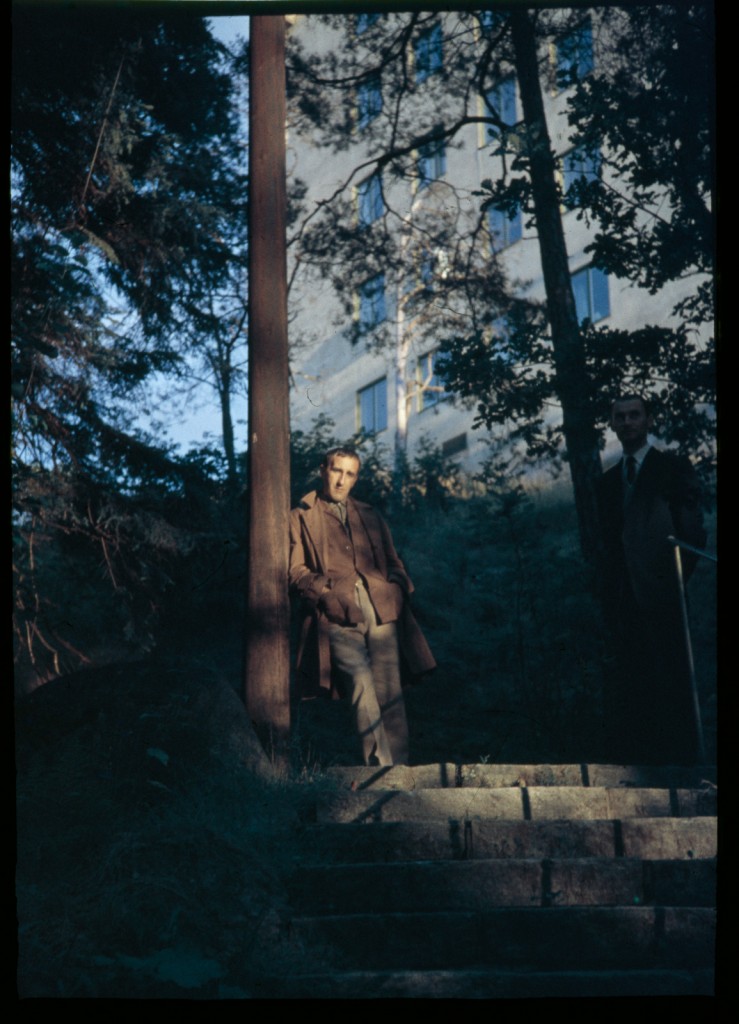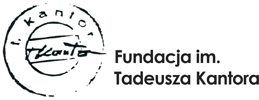6th of April, 1915 – 8th of December, 1990
Chronology
1915
Tadeusz Kantor was born on 6th April in Wielopole Skrzyńskie (currently Podkarpackie Voivodeship). He was the second child of Marian Kantor and Helena Kantor (née Berger). Marian Kantor, who had fought during the First World War, didn’t return home after the war ended. He moved to Silesia, where he was politically and culturally active, and known as Marian Kantor- Mirski.
1922 – 1924
Tadeusz Kantor attended primary school in Wielopole Skrzyńskie. In 1924 Helena Kantor together with daughter Zofia and son Tadeusz moved to Tarnów.
1925 – 1933
After graduating from primary school Tadeusz Kantor was enrolled at Kazimierz Brodziński 1st Gymnasium in Tarnów. He graduated from the gymnasium in 1933. During his gymnasium years he made his first attempts at painting and theatre.
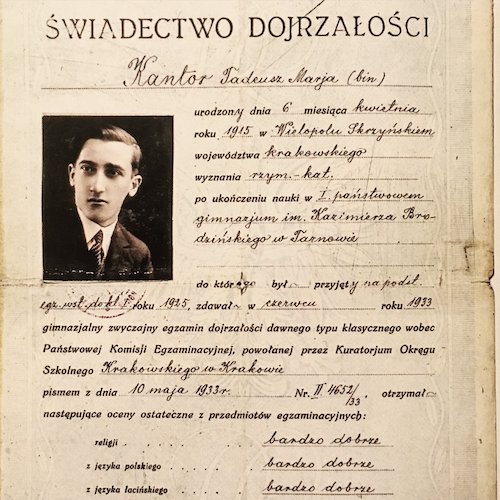 1933
1933
After his final exams Kantor moved to Cracow, where he commenced studies at the Faculty of Law and Administration at the Jagiellonian University. He quit after two weeks and was accepted at Ludwika Mehoffer School of Drawing and Painting.
1934 – 1939
In October 1934 Tadeusz Kantor began studies at the Faculty of Painting at the Academy of Fine Arts in Cracow. During the first four years he studied painting under Władysław Jarocki and Ignacy Pieńkowski. His last two years at the Academy were spent in Karol Frycz’s decorative and theatrical painting studio. An important event during his academic education was the first, independent attempt at staging The Death of Tintagiles by M. Maeterlinck, which took place at the Bratniak Student Club.
1939 – 1945
Kantor spent the war years in Cracow. He worked as a house painter to earn his living. In 1941 he painted frescos in the parish church in Nockowa. From 1942 to 1944 he was employed as a labourer at the Institut für Deutsche Ostarbeit, and also worked in the painting department of the Staatstheater. By order of the Nazi authorities he was also a forced labourer at Baudienst. During
the war, Kantor founded the Autonomous Underground Theatre which performed clandestinely in people’s flats. Kantor produced two plays with the Underground Theatre, both very important for the development of his artistic activity, Balladyna by J. Słowacki (1943) in the style of the Bauhaus, and The Return of Odysseus by S. Wyspiański (1944), using “poor”, real objects for the first time. Together with students from the Kunstgewerbeschule (the former Academy of Fine Arts), who, amongst others, had become his actors, he initiated meetings, discussions and organized public readings. Later they formed the Young Artists Group which was initiated by an exhibition of paintings at Ewa Siedlecka’s flat at Szewska Street in Cracow in 1943.
1945
In February, after the liberation of Cracow, Kantor was employed as head of the painting department at the Teatr Stary in Cracow. In March he enrolled at a scenographic course run by Andrzej Pronaszko. Later he used to help Pronaszko, who was head set designer at the Teatr Stary. Kantor designed sets for The Death of a Faun by T. Czyżewski, staged at the Dom Plastyków on 6th June, directed by W. J. Dobrowolski. On 17th July Kantor made his scenographic debut in the professional theatre in The Day of his Return by Z. Nałkowska, directed by J. R. Bujański, and on 24 th June as a painter at an exhibition of the Young Artists Group at Dom Literatów. He also continued with the experimental Autonomous Underground Theatre. He produced and directed The Worthy and the Unworthy by J. Czechowicz, which was shown at the Rotunda Academic Theatre on 2ndAugust. On 5th August the second version of The Return of Odysseus by S. Wyspiański was shown at the Studio Aktorskie at the Teatr Stary. Starting in autumn 1945, until mid-1946, Kantor worked at the Teatr Stary as assistant set designer and simultaneously taught students at the Studio Aktorskie. From 1945 to 1946 he designed a few sets for plays at the Teatr Stary. On 24th March Kantor married Ewa Jurkiewicz.
1946
In January Kantor published his first article, Suggestions of Scenographic Art in Przegląd Artystyczny magazine. In September Twórczość magazine published an article by Tadeusz Kantor and Mieczysław Porębki entitled Young Artists Group Once More. Pro doma sua, which was later proclaimed a manifesto of Magnified Realism. On 12th October an exhibition of the Young Artists Group opened at the the Palace of Art in Cracow. Kantor exhibited the magnified realism works he had painted in June and July (The Washerwoman, The Woman in a Door Frame, Bakers, The Ironing Lady, Fowlers). One of the works from this period, Portrait of a Painter, was selected by the national commission to represent Polish art at the International Exhibition of Modern Art organized by UNESCO at the Musée d’Art Moderne in Paris (18th November – 28th December 1946).
1947
The first six months of the year Kantor spent in Paris on an artistic scholarship he’d received from the Ministry of Culture. In France he had a chance to get acquainted with the latest achievements of international art. He became interested in the works of Kandinsky, Miró, Klee, Ernst, Hartung and Matta, but in his autobiography written years later, he mainly accentuated his Parisian discoveries related to an exhibition at the the Palais de la Découverte, where the latest achievements of science had been displayed (biological and geological specimens, mechanisms and machinery, etc.).They became the sources of inspiration for new drawings and paintings, in which he made attempts to depict the moving structure of matter, which created forms from the metamorphoses of space. It was the effect of a new way of perceiving the world, available only through scientific knowledge. Upon his return to Poland, Kantor was appointed (in the academic year of 1947/48) Professor at the State School of Fine Arts in Cracow. His earlier paintings were shown in the exhibition of the modern artists group at the Young Artists and Scientists Club, on 30th November.
1948
On 3rd February Kantor took part in an exhibition of Polish modern art, entitled Polish Art Today at The Kościuszko House in New York, which later travelled to Chicago and Washington D.C., and also in an exhibition entitled Young Polish Painters which was shown in Karlovy Vary, České Budějovice and Prague. On 6th April Kantor was appointed chairman of the Artists Club in Cracow and applied for a subsidy to the Ministry of Culture and Art in order to organize an exhibition which was to be a manifestation of new tendencies in Polish Art.
He was an initiator, organizer and curator of The 1st Modern Art Exhibition, which took place from 19th December 1948 to 13th February 1949 at the Palace of Art, and became the first postwar display of avant-garde artists. Kantor exhibited his metaphorical paintings, which were the fruits of his Parisian experiences.
1949
Kantor took part in the conference for artists organized by the Ministry of Culture and Art in Nieborów, on 12th – 13th February. During the conference he firmly argued with the theses of the programme department, which encouraged artists to practice Socialist Realism. As a result the Ministry of Culture and Art refused to subsidize the 1st Modern Art Exhibition in Wrocław and Łódź, and also came out against popularizing such exhibitions (cited after the Ministry of Culture and Art). Kantor spoke for the avant-garde art once again at the 4th General Convention of the Polish Graphic Artists’ Association, where Socrealism was proclaimed the obligatory trend in Polish art. In December Kantor gave his last lecture before the Stalinist night, entitled On Dreams. (On Art) at the State School of Fine Arts.
1950
Due to a negative evaluation of Kantor’s teaching, the Ministry of Culture and Art ordered Headmaster Wejman to give Kantor notice from the State School of Fine Arts on 1st March. On 1st September Kantor was employed as set designer by the State Dramatic Theatres in Cracow. He remained in this position until 1963 and designed his last scenery in 1974. Kantor regarded this as just a paid job, which had nothing to do with his genuine artistic activity, and so didn’t approach it with any artistic ambitions. However, even those of his designs which were closest to Socrealist concepts were considered formalistic, and only one of them was accepted for an exhibition entitled Artists Fighting for Peace shown at the Zachęta Gallery in November and December 1950 (it was a design for General Walter).
1951 – 1954
Staring from 1950 Kantor, together with a few other artists, ceased to take part in official artistic life. He worked intensivelly, but didn’t display either his paintings or drawings publicly. During this period he produced a number of commissioned set designs. After the death of Josef Stalin, the first attempts to abandon Socrealism were made at the 6th General Convention of Polish Graphic Artists’ Association, which took place in June 1954 in Warsaw. Some artists spoke up for broadening the spectrum of the criteria of Socialist Realism. Kantor made his first public speech for a few years, but the basic issues of art weren’t his concern in it. Another sign of the upcoming changes was the fact that Kantor was awarded The Golden Cross of Merit in August 1954. According to Kantor, his artistic prediction of “the thaw” was his set for No Trifling with Love by A. Musset in 1953.
1955
In 1955 Socialist Realism was abandoned. In January Kantor was awarded the Medal of the 10th Anniversary of the People’s Republic of Poland. In May he published his first article in seven years: Artistic Theatre in Życie Literackie magazine. He continued to work as set designer at theatres in Cracow, which also allowed him to visit Paris together with the Teatr Stary company which staged Summer in Nohant by J. Iwaszkiewicz, directed by R. Zawistowski with scenery designed by Kantor at the Festival of Nations in Paris. He visited Parisian galleries and discovered Lyrical Abstraction, Informelism, and Taschisme in the works of Pollock, Mathieu, Arnal, Tinguely and Wols. After his return to Poland, Kantor was given a merit award for his scenographic activity by the Committee of Public Awards on 22 nd July. In September, together with Maria Jarema and Kazimierz Mikulski, Kantor founded the experimental Cricot 2 Theatre at Dom Plastyków in Cracow, which in its structure referred to the prewar Artists’ Theatre – Cricot. On 13th November an exhibition of 9 painters (T. Brzozowski, M. Jarema, T. Kantor, J. Maziarska, K. Mikulski, J. Nowosielski, E. Rosenstein, J. Skarżyński and J. Stern) was opened at Dom Plastyków, which was a sign of the return of modernism in Polish art. On 20th November Życie Literackie published Kantor’s article about Informelism painting: Parisian Notes. On French Contemporary Painting. Kantor’s daughter Dorota was born.
1956
On 12th May Cricot 2 Theatre was inaugurated with the stagings of The Cuttlefish by S. I. Witkiewicz, directed by T. Kantor, with costumes designed by M. Jarema, and The Well – the Depth of Thought by K. Mikulski, directed by K. Mikulski and with scenery designed by J. Skarżyński. Kantor was awarded the Order of Polonia Restituta (Officer’s Cross) mainly for his scenographic works. On 15th November an initiatory meeting of the Cracow Group (Grupa Krakowska) Artistic Association was held. Amongst those present were: T. Brzozowski, M. Jarema, T. Kantor, P. Krakowski, W. Krakowski, A. Marczyński, J. Maziarska, K. Mikulski, D. Mróz, S. Mróz, J. Nowosielski, A. Pawłowski, T. Rudowicz, J. Skarżyński, J. Stern and M. Warzecha. The proposed constitution agreed that Cricot 2 Theatre would be included within the framework of the association’s activities. In December Kantor exhibitied his latest Art Informel paintings at the Salon Po Prostu in Warsaw.
1957
On 13th January Cricot 2 Theatre staged The Circus by K. Mikulski, directed by Kantor who also designed scenery for the play. It was accompanied by a presentation of Kineformy by A. Pawłowski. In February Kantor showed his metaphorical paintings (from 1948 to 1953) in a one man show at the Miejsce Museum in Lublin. In March the Państwowy Instytut Wydawniczy published Ivone, Princesds of Burgundia by W. Gombrowicz, illustrated by T. Kantor. On 9th May the Cracow Group (was reactivated, which referred to the prewar Cracow Group founded in 1932. Tadeusz Kantor became chairman of the Group, and the basement of the Krzysztofory Palace became the Group’s headquarters. On 10th July Kantor exhibited his paintings from 1948 to 1957 in the Palace hallway at the inauguration of the Krzysztofory Gallery. He also participated in the 2nd Exhibition of Contemporary Art at the Zachęta Gallery in Warsaw (18th October to 17th November). Wytwórnia Filmów Fabularnych in Łódź produced the first short film about Kantor’s Art Informel paintings, entiled Attention! Painting, directed by A. Nurzyński and M. Waśkowski, which was later shown at the 2nd Exhibition of Contemporary Art at the Zachęta Gallery, and a year later at the International Art Film Festival at the 29th Venice Biennale.
1958
In April and May Kantor participated in the exhibition Symbolism and Surrealism at the Art Historians Association. On 21st June, he took part in the official opening of the Krzysztofory Gallery where the first group exhibition of the members of the Cracow Group was shown. Kantor was the only Polish painter invited to participate in the exhibition at the Palais des Expositions in Charleroi, entitled L’art du XXI–e siécle. Rendez-vous de l’avant-garde internationale which took place between 5th August and 14th September. From August until December he was traveling in France and Sweden. He had the first solo exhibition of his paintings (works from 1950 to 1958) abroad at the Samlaren Gallery in Stockholm (22nd to 29th August).
1959
Between 6th and 28th March Kantor exhibited his paintings at a solo exhibition at Galerie H. Le Gendre in Paris. Two of his works were shown at Documenta 2 in Kassel (11th July to 11th October) and over 40 works from 1947 to 1959 were shown at a retrospective, monographic exhibition at Kunsthalle in Düsseldorf (13th November – 13th December). Kantor also participated in the 3rd Contemporary Art Exhibition in Warsaw.
1960
In September Kantor exhibited his works at Saidenberg Gallery in New York and in November at Galleri 54 in Gothenburg. He took part in the Expressions d’aujourd’hui exhibition at Château de Lunéville (14th May – 13th June) and in the 30th Venice Biennale.
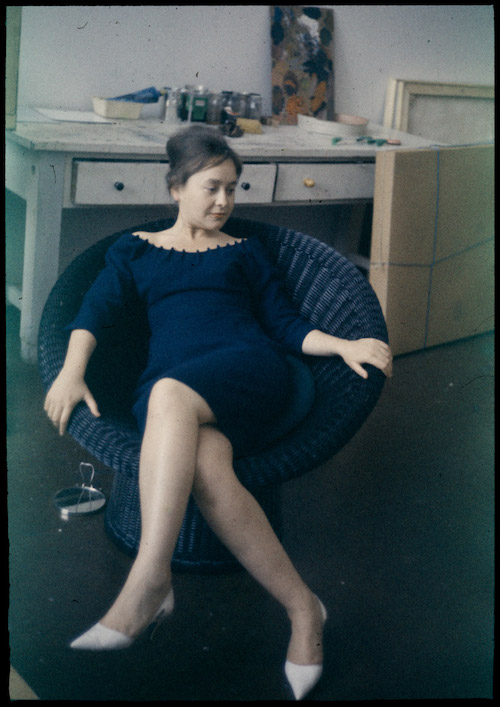 1961
1961
The premiere of In the Little Mansion at the Krzysztofory Gallery on 14th January initiated Kantor’s fully independent productions at Cricot 2 Theatre. He took this opportunity to proclaim the new stage of development of his theatrical activity, called “Art Informel Theatre”. This staging was also the beginning of his “game with Witkacy”, in which the verbal sphere of the performances constituted of S. I. Wikiewicz’s dramatic works (until 1980). Kantor participated in collective exhibitions in New York,The Art of Assemblage and 15 Polish Painters, at the Museum of Modern Art. From April until July he worked at the Hochschule für Bildende Künste in Hamburg. Kantor exhibited his latest paintings in October, in a solo exhibition, Peintures récentes at Galerie H. Le Gendre in Paris. In March (after divorcing Ewa Jurkiewicz) he married Maria Stangret in Paris.
1962
Kantor participated in collective exhibitions: Modern Paintings and Sculpture in Pittsburgh and Metafory in Sopot and Warsaw. He received the Ministry of Culture and Art award for his work in the field of fine arts.
1963
On 16th February the premiere of Bluebird’s Castle, Bartok’s opera directed and designed by Kantor, took place at the Teatr Wielki in Warsaw. This was his last work done for the traditional, professional theatre. (He rarely worked as a set designer thereafter). Years later, in a text entitled The Development of my Scenery Concepts he mentioned only a few of several dozen of his scenery projects made for professional theatres. These included stagings of: Measure for Measure by W. Shakespeare (1954), St. Joan by G. B. Shaw (1956), Antigone by J. Anouilh (1957), Rhinoceros by E. Ionesco (1961), The Candlestick by A. de Musset (1962). At Cricot 2 Theatre he produced a show The Madman and the Nun shown on 8th June at Krzysztofory Gallery. He published an Autonomous Theatre manifesto and proclaimed a new stage of development for Cricot 2 Theatre which he called “Teatr Zerowy” (“Zero Theatre”). Pamiętnik Teatralny magazine published Kantor’s article entitled Independent Theatre, 1942-1945. He participated in a collective exhibition Konfrontacje at the Krzywe Koło Gallery in Warsaw; in an exhibition of Polish painting at the Folkwang Museum in Essen; and in Polnisch Malerei vom Ausgang des XIX Jahrhunderts bis zur Gegenwart exhibition in Stuttgart. He curated his own solo exhibition at Krzysztofory Gallery (13th November to 15th December) entiled Wystawa Popularna. Anty-wystawa (Popular Exhibition. Anti-Exhibtion). In a manifesto, which accompanied the exhibition, Kantor declared his objection against stiff conventions regarding exhibitions and viewers. He began creating his first emballages.
1964
Invited by Theodor Ahrenberg, Kantor travelled to Switzerland, and then also went to Germany and Paris. In Lausanne he exhibited 26 of his paintings from 1957 to 1964 at a solo exhibtion at the Galerie Alice et Pierre Pauli (27th February – 19th March). Kantor participated in collective exhibitions: Beeldend experiment op de planken at the Stedelijk van Abbemuseum in Eindhoven (10th October – 22nd December) and Profile IV. Polnische Kunst heute at the Städlische
Kunstgalerie in Bochum (December 1964 – January 1965). Kantor exhibited his scenery designs at a scenographic exhibition Das Bühnebild nach 1945 at the Kunstgewerbemuseum in Zurich.
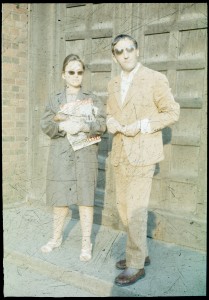 1965
1965
Invited by the Ford Foundation, starting in June, he traveled around the USA for six months. He got acquainted with new phenomena in American art (Minimal Art, Pop Art, Happening), the works of Robert Rauschenberg, John Cage, Jim Dine, and Allan Kaprow. He got to meet George Segal and Mark Rothko. After his return to Poland, Kantor established cooperation with young art critics
from Warsaw,Wiesław Borowski and Anka Ptaszkowska, and on their initiative he made the first Polish happening – Cricotage, on 10th December at a cafe at the Fine Arts Association. Some days later (on 19th December) his second happening, entitled The Division Line, took place at the headquarters of the Art Historians Association in Cracow. Kantor exhibited his works in: the Bild und Bühne exhibition at the Staatlische Kunsthalle in Baden-Baden (30th January – 9th May) and at the Fränkische Galerie in Nuremberg (21st May – 20th June), the Bilde og Scenebild exhibition at the Universitetsbiblioteket (2 nd September – 2nd October), at the Documenta 3 in Kassel and in the 4th Exhibition of the Cracow Group at Krzysztofory Gallery. He published a number of articles in Wiadomości Plastyczne magazine no. 23, which he had written in 1964 in Switzerland: Emballages Manifesto, A Meeting with Dürer’s Rhinoceros, It, and Clothing.
1966
From January to July Kantor stayed abroad, mainly in Germany. He exhibited his latest paintings- emballages (from 1964 and 1965) in a solo exhibition at the Staatlische Kunsthalle in Baden-Baden, (16th January to 13th February), and in the Les emballages exhibition at the Galerie de l’Université in Paris (17th March to 7th April). A premiere of the German version of In the Little Mansion by S. I. Witkiewicz, entitled Der Shrank and directed by Tadeusz Kantor, took place on 7th March in Baden- Baden. The show with German actors was accompanied by a book, the Komplexes Theater and was later shown in Munich, Heidelberg, Bochum and Essen. In May Kantor participated in a theatre festival Theater in Europa – Center in West Berlin. In August he took part in the Artists and Scientists Symposium in Puławy, Poland, where he received the Ministry of Culture and Art award for his work Emballage – Voyager. From 20th October to 1st November Kantor had a solo exhibition at the Galerie Handschin in Basel; in November and December his works were displayed at the Galerie Pierre in Stockholm. Kantor’s works were also exhibited in 17 Polish Painters exhibition at the d’Arcy Gallery in New York. He was commissioned to curate an exhibition of S. I. Witkiewicz’s works at the Zachęta Gallery in Warsaw. During his stay in Germany, Saarbrücken TV produced a film about him entitled Journey.
1967
On 21st January (at the Foksal Gallery, which opened on 1st April 1964 thanks to W. Borowski, A. Ptaszkowska and M. Tchorek) Kantor created a happening, Letter. On 4th April he organized a one day show of 20 of his emballages, which were later to be displayed during the 9th Biennale in São Paulo. On 28th April the premiere of The Water Hen by S. I. Witkiewicz took place at Cricot 2 Theatre and marked the beginning of a new stage of artistic theatre, later called “Teatr Wydarzeń” (“Theatre of Events”) or “Teatr Happeningowy” (“Happening Theatre”) by Kantor. An exhibition of his emballages, later sent to São Paulo, took place on 9th – 11th May at the Foksal Gallery in Warsaw. Kantor participated in the 2nd International Drawing Exhibition in Darmstadt (16th July to 10th September), Summer Warehouse (August – September) at the Foksal Gallery and in the Aspects. 5 ans d’activités á l’atelier du Rocher exhibition in Chexbres, Switzerland.
 On 23rd August at the 5th Koszalin plein-air in Osieki, Kantor produced his famous four-part Panoramic Sea Happening at a beach in Łazy. On 1st September he was appointed contract professor (for a period of 2 years) at the Faculty of Painting at the Academy of Fine Arts in Cracow. On 16th October Cricot 2 Theatre performed The Water Hen at Zachęta Gallery in Warsaw (first performance outside Cracow). On 18th December Kantor was appointed chairman of the Cracow Group.
On 23rd August at the 5th Koszalin plein-air in Osieki, Kantor produced his famous four-part Panoramic Sea Happening at a beach in Łazy. On 1st September he was appointed contract professor (for a period of 2 years) at the Faculty of Painting at the Academy of Fine Arts in Cracow. On 16th October Cricot 2 Theatre performed The Water Hen at Zachęta Gallery in Warsaw (first performance outside Cracow). On 18th December Kantor was appointed chairman of the Cracow Group.
1968
Tadeusz Kantor was awarded 2nd prize in painting at the São Paulo Biennale which finished on 8th January. In March and April he was in Germany, where he participated in a symposium Prinzip Collage (29th March – 3rd April) and in an exhibition Von der Collage zur Assemblage (4th April –12th May) organized by the Institut für Moderne Kunst in Nuremberg. In April and May (for the film made by Saarbrücken TV, in cooperation with Dietrich Mahlow, director of Kunsthalle in Nuremberg) Kantor produced happenings: Lesson in Anatomy According to Rembrandt, Conversation with the Rhinoceros and Die Grosse Emballage. In July and August, in the Summer Warehouse exhibition at Foksal Gallery, Kantor presented his paintings from the emballages series and some drawings. In August and September he participated in an artistic plein- air dedicated to mosaics in Vela Luka, Yugoslavia. He created The Chair-Emballage covered in mosaics. On 30th October he created a happening, Hommage á Maria Jarema, at the Krzysztofory Gallery. At the end of 1968 and beginning of 1969 Cricot 2 Theatre gave a number of performances of The Water Hen. Kantor was awarded the European award for painters “Premio Marzotto”.
1969
On 18th January he participated in the Winter Assemblage organized by Foksal Gallery and presented an action entitled The Typewriter with a Sail and a Rudder. On 24th January he prepared the second version of Lesson in Anatomy according to Rembrandt at the Foksal Gallery. On 30th April Cricot 2 Theatre went on tour in Italy until 12th May; they performed at Premio Roma festival at the Galeria Nazionale d’ Arte Moderna in Rome, and then in Modena and Bologna. In August Kantor produced a series of eight happenings in Bled, Yugoslavia, for a film which was being made by Saarbrücken TV, entitled Impossible Theatre. He was also the person behind the concept of the action We aren’t Sleeping produced by his students from the Academy of Fine Arts during the exhibition, and the symposium Złote Grono in Zielona Góra (25th – 27th September). Kantor’s contract at the Academy wasn’t extended on the 1st October, even though his students strongly protested against this decision.
1970
In January an exhibition, Conceptual Emballages, was shown at the Krzysztofory Gallery. On 21st February Kantor conducted the first stage of the painting action Multipart and created the Multipart manifesto at the Foksal Gallery.
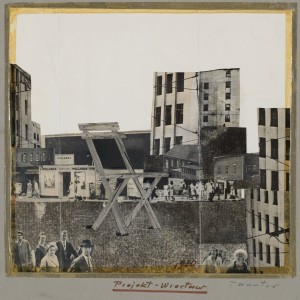 On 17 th March, at the Art Symposium Wrocław ’70 Kantor presented a project of a gigantic concrete chair built into a public space (from the cycle Impossible Sculptures). He participated in an exhibition 3e Salon International de Galeries Pilotes at Musée Cantonal de Beaux Arts in Lausanne (21st April – 4th October), which later traveled to the Musèe d’Art Moderne de la Ville de Paris (28th October – 6th December). In June he presented one of the versions of Multipart at the Galerie Alice et Pierre Pauli In Lausanne. On 23rd September he curated a documentary exhibition Happening and Happening-like Actions 1963-1970 at the Foksal Gallery. He participated in the Elektra 70 exhibition in New York. He also took part in Harald Szeemann’s exhibition Happening & Fluxus at the Kölnischer Kunstverein. Documentation of the approximately 500 most important happenings from 1959 to 1970 were shown in the exhibition (16th December 1970 to 6th January 1971). These included Kantor’s Letter, Panoramic Marine Happening and Lesson in Anatomy according to Rembrandt.
On 17 th March, at the Art Symposium Wrocław ’70 Kantor presented a project of a gigantic concrete chair built into a public space (from the cycle Impossible Sculptures). He participated in an exhibition 3e Salon International de Galeries Pilotes at Musée Cantonal de Beaux Arts in Lausanne (21st April – 4th October), which later traveled to the Musèe d’Art Moderne de la Ville de Paris (28th October – 6th December). In June he presented one of the versions of Multipart at the Galerie Alice et Pierre Pauli In Lausanne. On 23rd September he curated a documentary exhibition Happening and Happening-like Actions 1963-1970 at the Foksal Gallery. He participated in the Elektra 70 exhibition in New York. He also took part in Harald Szeemann’s exhibition Happening & Fluxus at the Kölnischer Kunstverein. Documentation of the approximately 500 most important happenings from 1959 to 1970 were shown in the exhibition (16th December 1970 to 6th January 1971). These included Kantor’s Letter, Panoramic Marine Happening and Lesson in Anatomy according to Rembrandt.
1971
On 20th February Kantor produced the second and last stage of the Multipart at the Foksal Gallery and created Manifesto 70. As part of a cycle of 9 individual exhibitions curated by Foksal Gallery, Kantor displayed projects of Impossible Monuments and Conceptual Emballages on 6th April.
In June he participated in a scenographic exhibition Vår Tids Scenebilde at the Sonja Hoenje – Onstadt Kunstcenter in Høvikodden near Oslo. From 28th April to 8th May Cricot 2 Theatre were in France and performed The Water Hen in Nancy and Paris. At the Foksal Gallery on 1st September Kantor displayed documents and photographs related to his works done in cooperation with the Foksal Gallery. The exhibition was entitled Live Archive – Documentation. In September, together with Cricot 2 Theatre’s actors, critics and associates, he participated in I Atelier International de Théâtre Experimental in Dardan, near Paris, where he presented the happenings Laundry Room and Lesson in Anatomy according to Rembrandt. On 8th September he created Impossible Monument – The Chair (14 m high) which was placed in close proximity to the Sonja Hoenje – Onstadt Kunstcenter (broken by the wind a year later). On 9th November Kantor presented the Cambriolage action at the Foksal Gallery. Kantor participated in the International Scenographic Quadrennial in Prague.
1972
Kantor exhibited his works at the Desa Gallery in Cracow (19th – 29th February). From 9th May to 3rd June The Shoemakers by S.I. Witkiewicz was staged at Théâtre 71 in Paris (with actors from Cricot 2 Theatre and La Compagnie Charbonnier). Cricot 2 Theatre presented The Water Hen at the Festival of Art in Edinburgh (20th August – 9th September). From November until January 1972 The Water Hen was performed on numerous occasions in Łódź and at the Krzysztofory Gallery in Cracow.
1973
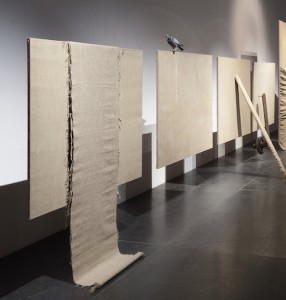 Kantor exhibited his new painting cycle Everything Hangs on by the String at the Galeria Foksal on 10th March. On 4th May Cricot 2 Theatre presented the premiere of Dainty Shapes and Hairy Apes by S. I. Wikiewicz at the Krzysztofory Gallery. Kantor called this phase of his artistic pursuit “Teatr Niemożliwy” (“Impossible Theatre”). The play was shown at the Krzysztofory a number of times until the beginning of June, and then, again in mid-December. Cricot 2 Theatre went on tour in Scotland from 19th August to 14th September, showing Dainty Shapes and Hairy Apes in Edinburgh (here Tadeusz Kantor met Joseph Beuys, who had come to see the play and later used a door with the remains of the Cricot 2 poster in his work Poor House Door – A New Beginning is in the Offing) and in Glasgow. Krzysztof Miklaszewski directed The Cloakroom – the first Polish film about Kantor’s theatre in which he used footage from rehearsals and shows of Dainty Shapes and Hairy Apes.
Kantor exhibited his new painting cycle Everything Hangs on by the String at the Galeria Foksal on 10th March. On 4th May Cricot 2 Theatre presented the premiere of Dainty Shapes and Hairy Apes by S. I. Wikiewicz at the Krzysztofory Gallery. Kantor called this phase of his artistic pursuit “Teatr Niemożliwy” (“Impossible Theatre”). The play was shown at the Krzysztofory a number of times until the beginning of June, and then, again in mid-December. Cricot 2 Theatre went on tour in Scotland from 19th August to 14th September, showing Dainty Shapes and Hairy Apes in Edinburgh (here Tadeusz Kantor met Joseph Beuys, who had come to see the play and later used a door with the remains of the Cricot 2 poster in his work Poor House Door – A New Beginning is in the Offing) and in Glasgow. Krzysztof Miklaszewski directed The Cloakroom – the first Polish film about Kantor’s theatre in which he used footage from rehearsals and shows of Dainty Shapes and Hairy Apes.
1974
In February Cricot 2 Theatre presented Dainty Shapes and Hairy Apes in Łódź; and in April and in October at the Krzysztofory Gallery. In April and May Cricot 2 Theatre toured France and Italy with the Dainty Shapes and Hairy Apes show. They performed in Paris, Nancy and Rome. Moreover, the play was shown at the Art Festival in Shiraz (19th – 21st August), in Essen in November and in Warsaw in December. The premiere of Balladyna by J. Słowacki, directed by M. Górkiewicz with scenery designed by T. Kantor (his last work for the professional theatre) took place on 26th October at the Bagatela Theatre in Cracow. The B Gallery in Gniezno published the Impossible Theatre manifesto. Kantor was awarded the C. K. Norwid Art Critics Award.
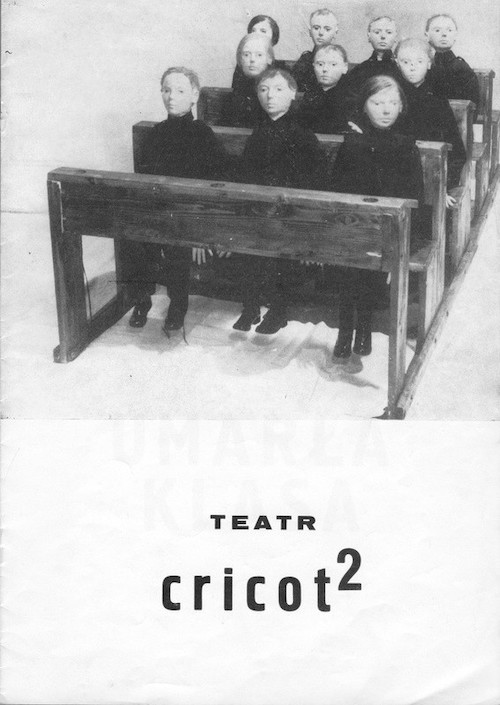 1975
1975
In January Kantor began the Dead Class rehearsals at the Krzysztofory Gallery. In May he exhibited his paintings in a solo exhibition Emballages at the Muzeum Sztuki in Łódź, and in June it traveled to the Kulturhuset in Stockholm. In September, commissioned by the National Museum in Cracow, he made Prussian Homage Emballage, which was exhibited at the Sukiennice (Drapers Hall), and participated in a collective exhibition In the Sphere of Hyper-Realism (W kręgu nadrealizmu) in Wrocław.
On 11th September a public rehearsal of Dead Class took place at the Krzysztofory Gallery, accompanied by a book, Dead Class Manifesto. Dead Class had its premiere on 15th November at the Krzysztofory Gallery, and was performed in Cracow until early December and in Łódź in mid-December. Simultaneously Foksal Gallery published the Theatre of Death manifesto, in which Kantor proclaimed a new stage of development of Cricot 2 Theatre. He exhibited his drawings in Rezerwat Ludzki (Human Reservation) exhbition at the Zapiecek Gallery in Warsaw and the Desa Gallery in Cracow.
1976
Dead Class was performed at the Krzysztofory Gallery from 17th January until 17th May. The opening of an exhibition of W. Szperl’s photographs from the Dead Class performance took place on 10th February at the Foksal Gallery. Kantor gave a lecture, The Theatre of Death Concept, at the Polish Artists Association. In March the Krzysztofory Gallery showed an exhibition about Cricot 2 Theatre. On 27th, 28th and 29th May, three performances of Dead Class took place in Wrocław. In June a solo exhibition From Itaka to Dead Class was opened at the Zapiecek Gallery in Warsaw. Kantor participated in a collective exhibition which documented the activities of the Foksal Gallery, entitled Documents of the Artists. Documents of the Gallery (1966-1976). In August and September Cricot 2 Theatre toured Great Britain for six weeks, which initiated the triumph of Dead Class on stages around the world. The play was shown in Edinburgh (The Scotsman Award), in Cardiff and London.
From 22nd September to 31st November the Art Museum in Łódź curated Kantor’s individual exhibition Emballages (which also included happenings, documentation and Multiparts) which was shown at the Whitechapel Gallery in London and later traveled to the Sonja Hoenje Niels – Onstadt Kunstcenter in Norway and the Galerie Trondheim. In October Kantor curated an exhibition of photographic documentation of Cricot 2 Theatre activity, entitled Live Documentation – 20 years of Cricot 2 Theatre. In November he exhibited his latest paintings in a solo exhibition Emballages 1960-1976 at the Galerie R. Johan Ricard in Nuremberg. Andrzej Wajda and Denis Bablet filmed Dead Class. On 19th and 20th December Dead Class was staged in Warsaw.
1977
In January, at the request of the Ludwik Solski State Theatre School on its 30th anniversary, Kantor designed scenery for the staging of Pan Tadeusz by A. Mickiewicz, directed by I. Babel and performed at the J. Słowacki Theatre in Cracow (premiere on 10th January). Cricot 2 Theatre traveled with Dead Class to: Amsterdam, Nuremberg, Erlangen, Nancy, Shiraz, Belgrade (received the Grand Prix at BITEF Festival), Paris, Lyon, Lille, Brussels and Gent. In Poland Dead Class was shown at the Krzysztofory Gallry and three times at the Stodoła Club in Warsaw. On 2nd December Kantor showed his drawings from 1947 – 1977 in a solo exhibition at the Galerie R. Johan Ricard in Nuremberg. On 10th December he curated an exhibition 22 years of Cricot 2 Theatre and Underground Theatre 1942-1944 at the Foksal Gallery. He participated in Documenta 6 in Kassel and in a collective exhibition International Art Exhibition ROSC – The poetry of Vision in Dublin (21st August – 30th September). L’Age d’Homme published Kantor’s writings on theatre Théâtre de la Mort, with a preface by D. Bablet (later translated into Italian, Spanish, German and Japanese).
1978
Throughout the year Cricot 2 Theatre performed Dead Class in Florence, Milan, Adelaide, Sydney, Zürich, Geneva, Caracas (Juan Sujo Premio Teatral Award), Rome, West Berlin, Stuttgart and Gratz. The opening of Caroline Roses’s exhibition Photograms of Tadeusz Kantor’s Cricot 2 Theatre took place on 3th April at the Foksal Gallery. Tadeusz Kantor was awarded the Rembrandt Award for his painting works by the Goethe Foundation in Basel. The ceremony took place on 8th April at the National Museum in Cracow – Kantor read his Little Manifesto there. Cricot 2 Theatre performed Dead Class at the Krzysztofory Gallery, and in November at the Rotunda Club in Cracow. Kantor was awarded the City of Cracow Award for dissemination of culture.
1979
From 25th January until 4th February an exhibtion Le opere di Tadeusz Kantor. I pittori di Cricot. Il Teatro Cricot 2 (a part of L’avanguardia polacca 1910 – 1978 exhibition) was organized at the Palazzo delle Esposizioni in Rome and later moved to the Palazzo Reale in Milan. Apart from showing his paintings, Kantor, together with artists and actors of Cricot 2 Theatre, made a cricotage Where are Last Year’s Snows, according to F. Villon, and presented it on 27th January during the exhibition in Rome. Cricot 2 Theatre toured New York (OBIE Award), Mexico City, Milan and Stockholm, performing Dead Class. Kantor participated in a retrospective documentary exhibition curated by the Foksal Gallery, which was displayed from 20th August to 15th November at the Richard Demarco Gallery in Edinburgh, The Third Eye Centre in Glasgow, ICA in London and the Project Art Centre in Dublin. Kantor participated in the 3rd Biennale in Sydney. In October Cricot 2 Theatre traveled to Florence, invited by the city authorities (Comune di Firenze) and Teatro Regionale Toscano, in order to produce a new show. The authorities of Florence planned to create Cricoteka – a centre for documentation and support of Cricot 2 Theatre. In December the authorities of Cracow decided to hand over some space at 5 Kanoniczna Street to Cricot 2 Theatre in order to create a centre there.
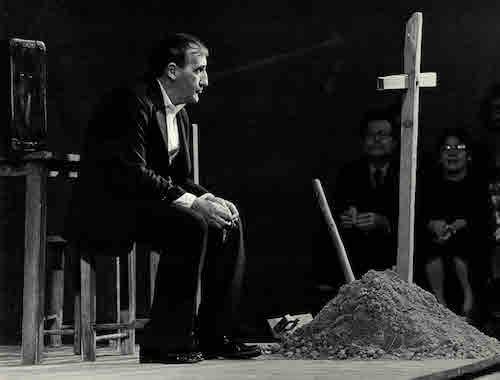 1980
1980
An exhibition Cricot 2 Theatre Concepts (Idee Teatru Cricot 2) opened on 19th January and inaugurated the founding of Cricoteka in Cracow.
On 23rd June at the deconsecrated church of Santa Maria, which the city of Florence earmarked for Cricot 2 Theatre, after almost 8 month of rehearsals, the world premiere of T. Kantor’s Wielopole, Wielopole took place. Repeat performances in Florence went on until 2nd July. Kantor engaged some Italian actors, when Cricot 2 became an international theatre (later actors from other countries were engaged too). From 26th August until 2nd October Cricot 2 Theatre presented Wielopole, Wielopole in Edinburgh, London and Paris; and Dead Class in Prato. In November and December Wielopole, Wielopole was shown in Cracow, Warsaw and Gdańsk.
1981
On 1st January the Cricot 2 Theatre Centre, which had operated as part of the Bureau of Artistic Exhibitions (Biuro Wystaw Artystycznych), became an independent institution under the Department of Culture of the Cracow City Council. Cricot 2 Theatre went on tour with Wielopole, Wielopole to Milan, Rome, Florence, Genoa, Parma, Geneva, Zurich, Caracas, Nuremberg, Madrid, and Vitoria. In June Dead Class was performed at Sokół a couple of times. Cricoteka launched two exhibitions: Exhibition – Obligatory Reading (Wystawa – Lektura) – an exhibition of theatre scripts of Cuttlefish and Wielopole, Wielopole, and Artists of the Cricot 2 Theatre (Artyści z kręgu Cricot 2). Kantor was awarded the Minister of Culture and Art award for his artistic activity and outstanding achievements in the field of culture. The Italian publishing house Ubulibri published a book with a script and Kantor’s theoretical commentaries to Wielopole, Wielopole (later also published in Polish and English). On 12th December Kantor participated in an independent Polish Culture Congress.
1982
Kantor presented his works from 1947 to 1981 (paintings, objects, drawings) at a solo exhibition, Metamorphoses, at the Galerie de France in Paris (4th March – 7th May). The exhibition catalogue was published by Edition Chêne/Hachette and Galerie de France and included (as well as painting reproductions) a set of Kantor’s texts and essays. Cricot 2 Theatre performed Wielopole, Wielopole in Guanajuato, Mexico City, New York (OBIE award) and Lyons; and Dead Class in Toga-mura, Tokyo and London. The Cricotage Where are Last Year’s Snows was shown in Paris and London. Kantor participated in collective exhibitions: Échange entre Artistes 1931 – 1982. Pologne – USA at the Musée d’Art Moderne de la Ville de Paris (25th July – 6th October) co-curated by the the Foksal Gallery and the Art Museum in Łódź, and in the 11th Venice Biennale, in an international exhibition at the main pavilion Arte come arte: persistenza del’la opera. Wydawnictwo Artystyczne i Filmowe publishing house published Wiesław Borowski’s book (written in 1975) Tadeusz Kantor, which consisted of an extensive interview with Kantor conducted in 1973 and 1974, a brief chronology of events, and a selection of Kantor’s writings. Kantor received the Order of Polonia Restituta (Commander’s Cross).
1983
Cricot 2 Theatre performed Wielopole, Wielopole in Valencia, Palma de Mallorca, Warsaw, Cracow, Wielopole Skrzyńskie (at the parish church) and Rzeszów; and Dead Class in Cagliari, Madrid, Warsaw, Cracow, Paris, and Geneva. Where are Last Year’s Snows was presented in Geneva. Kantor participated in a collective exhibition of Polish art, Présence Polonaise, at the Centre Georges Pomipidou in Paris (23th June – 26th September). In September (19th – 28th) he curated an exhibiton La troupe Cricot 2 et son Avant-garde at the Centre Georges Pomipidou in Paris. Centre National de la Rechereche Scientifique published volume 9 of Les voies de la création théâtrale, edited by D. Bablet – a book that discussed Tadeusz Kantor’s Theatre of Death (Teatr Śmierci).
1984
An exhibition of 20 artists connected with the Foksal Gallery was presented at the Foksal Gallery from 22nd March to 15th April. The idea behind the exhibition was to defend the gallery’s independence against being taken over by the newly founded ZPAMiG. (The Foksal Gallery, in a protest against marshal law, ceased from exhibiting in 1981). Tadeusz Kantor took part in the press conference which was held on 12th April and defended the gallery, stressing its undeniable impact on his own artistic career. Kantor exhibited his works (paintings and objects) in a solo exhibition at the Maison de la Culture in Grenoble (5th October – 20th December). Cricot 2 Theatre performed Wielopole, Wielopole in Stockholm, Jyväskylä, Helsinki, Paris, Los Angeles, Buenos Aires, Grenoble, Louvain–la-Neuve and Bologna. Dead Class was shown in Murcia, Las Palmas, Seville and Los Angeles. Where are Last Year’s Snows was performed in Warsaw on 2nd, 3rd and 4th May.
1985
In February Kantor was awarded the Legion of Honour in France. In January Cricot 2 Theatre went to Nuremberg, where they rehearsed the new show. The premiere of Let the Artists Die took place on 2nd June atthe Alte Gieserei Kabelmatall in Nuremberg. This new work was created in cooperation with the Institut für Moderne Kunst in Nuremberg and the Centro di Ricerche Teatrali in Milan. In 1985 Let the Artists Die was also performed in Milan, Avignon, Paris and New York (OBIE Award). Wielopole, Wielopole was staged in Saloniki. Dead Class was performed in Tel Aviv. In July Kantor exhibited his paintings and drawings, together with Maria Stangret’s works, at the Salle de Théologie du Palais des Papes in Avignon. Cricoteka launched two exhibitions: School Class – a Finished Work of Art and Witkacy and Cricot 2 Theatre. Two films were made: Andrzej Sapija’s Cricot 2 Theatre and Denis Bablet’s Tadeusz Kantor – Théâtre. The building of the house of Maria and Tadeusz Kantor in Hucisk was completed.
1986
On 10th January the Foksal Gallery launched an exhibition of drawings for Let the Artists Die curated by Tadeusz Kantor. Cricot 2 Theatre performed Let the Artists Die in Warsaw, Cracow, Madrid, Milan, Turin, Lyon, Grenoble, West Berlin, and Ferrara; and Wielopole, Wielopole in West Berlin. The Silesian University in Katowice organized a symposium Tadeusz Kantor’s Art (10th – 11th April). A conference about Tadeusz Kantor’s art Lattesa molto importante took place at the Teatre Petruzzelli in Bari (1st – 10th May), accompanied by the Cricot 2 Theatre festival at which Dead Class, Wielopole, Wielopole and Let the Artists Die were performed. Kantor also presented his works in a solo exhibition at Bonomo Gallery in Bari. He conducted classes with students at Civica Scuola d’Arte Drammatica in Milan from 25th June to 25th July. Their outcome was a cricotage, The Wedding, performed three times by students at the end of the course (21st, 22nd, 23rd July) at Sala Azzurra in Milan. A book of Kantor’s lectures Lezioni Milanesi was published two years later. Kantor exhibited his paintings and object in a solo exhibition, Hommage á Tadeusz, which opened on 31st August at the Galerie Eva Poll in West Berlin. Along with the Cricot 2 Theatre performance at Theatermanufaktur in West Berlin, a retrospective exhibition of Cricot’s history was shown in the theatre hall. A symposium about Tadeusz Kantor’s art was held at the De Singel Theatre in Antwerp, accompanied by performances of Let the Artists Die and an exhibition of Kantor’s drawings (21st – 25th October).
1987
Cricot 2 Theatre performed Let the Artists Die on tour in Wrocław, Barcelona, Lille, Vienna, Bilbao, Florence, Buenos Aires; and Wielopole, Wielopole in Barcelona and Santander. Commissioned by Museo delle Marionette in Palermo and Centro di Ricerche Teatrali in Milan, Kantor produced a Cricotage The Machine of Love and Death, which had its premiere at Documenta 8 in Kassel on 13th June, and was later shown in Milan, Reggio Emilia and Palermo (accompanied by an exhibition Oggetti e macchine del teatro di Tadeusz Kantor and a book of the same title). Nat Lilenstein filmed Let the Artists Die for La Sept channel. Cricoteka launched two exhibitions ragarding the stagings of The Shoemakers (1972) and Balladyna (1974). In December Kantor started rehearsing his new play at the Krzysztofory Gallery.
1988
In January Cricot 2 Theatre performed Let the Artists Die in San Marino and Salerno. In January and February Cricoteka showed an exhibition of Kantor’s drawings entitled Cathedrals of Barcelona, and from 5th to 12th March displayed his latest paintings from the cycle Further on Nothing…. Rehearsals of Kantor’s new play commenced in mid-March in Milan. It was produced in cooperation with the Centro di Ricerche Teatrali in Milan, the Kulturstadt Berlin, and the Festival d’Automne and Centre Georges Pompidou in Paris. The premiere of I shall Never Return took place on 23rd April at the Piccolo Teatro Studio. The play was shown there until end of the month, and later performed in West Berlin, New York, Paris, Palma de Mallorca, Toulouse and Lyons. In June The Machine of Love and Death was performed in Helsinki and Vaasa. From 16th August until 10th September Kantor was in Charleville – Mézières (invited by the Institut International de la Marionette), where, together with an international group of mimes, actors and puppeteers he worked on a Cricotage, Une très courte leçon. Kantor received the National 1st Class award for his theatre works. Verlag für Moderne Kunst published his theoretical texts and manifestos in a book entitled: Tadeusz Kantor. Ein Reisender – seine Texte und Manifeste, translated by Piotr Nawrocki.
1989
Cricot 2 Theatre performed I shall Never Return in Montpellier, Marseille, Lille, Barcelona, Madrid, Rome, Lisbon and Nuremberg. On 8th March Kantor was awarded the Commandeur de l’Ordre des Arts et Lettres. In May and June a series of events entitled Le retour, dedicated to Kantor’s art took place in Paris. These included: the Cricot 2 Theatre festival entitled Theatre of Love and Death – Cricot 2 with performances of Wielopole, Wielopole, Let the Artists Die and I shall Never Return; exhibitions of paintings and theatrical objects: Plus Loin, Rien at the Galerie de France, and Tadeusz Kantor. Le voyage at the Centre Georges Pompidou; and the international symposium Tadeusz Kantor peintre, homme de théâtre, ses résonnance á la fin du XX siécle at the Centre Georges Pompidou. Two films were made: The Return of Odysseus directed by Andrzej Sapija, and La classe morte by Nat Lilenstein.
1990
On 25th February Kantor was awarded the Order of Merit of the Federal Republic of Germany. Cricot 2 Theatre performed I shall Never Return in Cracow, Warsaw, Tokyo, Salerno, Bari, Reykjavik and Toulouse; and Let the Artists Die in Tokyo. The latest drawings for the newest play Today is my Birthday were exhibited at Galerie Eva Poll in Berlin in an exhibition entitled Tadeusz Kantor zum 75 Geburstag. Neue Zeichnungen (2nd – 30th April), and in April at Foksal Gallery in an exhibition entitled Today is my Birthday. An international symposium, Art and Freedom, was held at the Jagiellonian University in Cracow, dedicated to Tadeusz Kantor’s works (9th – 11th April). In April, in a solo exhibition at the Galeria Spicchi dell’Est in Rome, Kantor presented almost 50 works (objects, paintings, drawings) from 1950 to 1990. From 12th June to 13th July Kantor led an apprenticeship with a group of 20 French actors selected in a competition organized by the Académie Expérimental des Théâtres, with whom he produced his last cricotage Ô douce nuit (Silent Night), sponsored by the Académie Expérimental des Théâtres in Paris and the Institut Supérieur des Techniques du Spectacle in Avignon. The cricotage was shown four times in July at the Chapelle des Pénitents Blancs, at theatre festival in Avignon. In August Cricoteka launched an exhibition of Kantor’s drawings, entitled: Travel Journal of Tadeusz Kantor, and in November displayed almost 40 drawings for Cricotages: The Wedding, The Machine of Love and Death, A Very Short Lesson, Silent Night. The Objects and Memory Plates of Cricot 2 Theatre exhibition was shown at the Biuro Wystaw Artystycznych in Wrocław. Kantor participated in a meeting, Underground Theatre – the avant-garde – Tygodnik Powszechny magazine (Teatr Podziemny – awangarda – Tygodnik Powszechny) with Jerzy Turowicz on 28th November. Kantor was awarded the Prix Pirandello award.
On 8th December, after an evening rehearsal of Today is my Birthday (to be premiered in January 1991) Kantor died suddenly.
